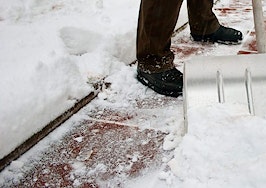- Prepare well for winter weather, and the earlier, the better.
- It's crucial to inspect the property and regularly check building temperatures.
- Temperature monitoring is especially imperative in vacant properties or those that are closed for the holidays.
The perfect time to prepare your real estate for winter weather is before the extreme cold or heavy snow and rain make repairs impossible. The fallout of not completing a thorough inspection could be financially devastating, and many times disaster can be avoided with a little forethought and thorough inspection.

stocksolutions / Shutterstock.com
For example, residents in a Montreal apartment building woke to an inch of water on the floor from clogged roof drains. After a sudden heavy rain, the water level rose over the roof parapet and infiltrated the building’s interior walls. This incident could have been avoided had the building owner checked the roof and gutter spouts.
To mitigate property damage from extreme cold, inspect the building envelop and regularly check and monitor building temperatures either with the assistance of an alarm or by making regular rounds.
Temperature monitoring is particularly important for vacant or unoccupied property if the place is closed for holidays.
Although cold temperatures in the north are common, the risk of freezing is present across all geographies. In warmer regions, simply activating portable heaters might be all that’s necessary to avoid freezing pipes and other cold damage when temperatures drop.
Guidelines for inspection
Waiting until the last minute to inspect your property and make repairs could be costly and might cause dangerous situations for your tenants and employees. By following a few simple steps, you can mitigate the hazards associated with property damage and resident injury due to cold weather.
Use this checklist to get things in order, and save yourself from having to make costly emergency repairs in the future.
Roof
- Conduct a full inspection at least once each year. Replace and repair damages that show signs of weakness, sagging or decay.
- Pay attention to any interior or exterior conditions that might indicate the roof is leaking.
- Keep roof, valleys, gutters and downspouts free from buildup of leaves, twigs and other litter, which could prevent proper drainage and lead to water infiltration.
- Inspect all flashing and caulking. Leaks are more susceptible around items that have been cut into the roof, including attic vents, sewer vents, chimneys and skylights.
- Keep flashing or coping around the edge of the roof in good condition.
- Inspect the roof structure for any sign of structural damage that can lead to collapse.
- Consider installing soffit vents to increase ventilation and prevent mold caused by heat and moisture buildup in the attic.
Snow removal
- Review your roof snow removal practice to prevent damage and injuries.
- Review your snow removal and maintenance contracts to ensure you are adequately protected from liability.
Cold weather preparation
- Inspect the heating equipment.
- Inspect the building envelope.
- Monitor the temperature of areas subject to freezing.
- Implement a weather watch with procedures for alerting management.
- Have an arrangement for the maintenance personnel to be available during expected cold periods.
- Maintain an inventory of all portable heating equipment owned or from all other sources.
Thorough preparation before winter should help real estate owners prevent damage to the property as well as reduce potential liability issues.
Leopold Boutin, senior risk consultant for HUB International.








